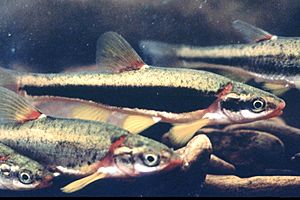Blackside dace facts for kids
Quick facts for kids Blackside dace |
|
|---|---|
 |
|
| Conservation status | |
| Scientific classification | |
| Genus: |
Chrosomus
|
| Species: |
cumberlandensis
|
| Synonyms | |
|
Phoxinus cumberlandensis Starnes & Starnes, 1978 |
|
The blackside dace (Chrosomus cumberlandensis) is a small, ray-finned fish. It belongs to the Cyprinidae family, which includes carps and minnows. This fish is special because it lives only in the Cumberland River area. You can find it in parts of Kentucky, Tennessee, and Virginia in the United States. The blackside dace is currently listed as a threatened species. This means it needs protection to survive.
Contents
What the Blackside Dace Looks Like
This fish is quite small. It usually grows to be about 50 to 65 millimeters long. That's about 2 to 2.5 inches. Its body is mostly olive green. It has small black spots and a clear black stripe along its side.
When it's time to have babies, from April to July, the blackside dace changes color. The black stripe gets much darker. Red patches appear on its upper body. Its fins also turn a bright yellow. These colors help them attract a mate.
Where It Lives and What It Does
The blackside dace lives in about 105 streams. These streams are mostly in Kentucky and Tennessee. However, many of these groups of fish are very small. Some have fewer than 10 individual fish. Some blackside dace have been found in western Virginia. Scientists think these fish were put there by people.
This fish likes cool, clear streams. These streams usually have rocky bottoms. They also have plants hanging over the water. Blackside dace often swim together in groups. They like to hide under banks and rocks.
Other fish share the same home. These include the common creek chub and the white sucker. You might also see the stoneroller and the stripetail darter. The blackside dace mostly eats algae. Sometimes, it will also eat small insects.
Blackside dace usually live for 2 to 3 years. They can start having babies when they are just one year old. A female fish can lay about 1,540 eggs on average.
Why Blackside Dace Are in Danger
The biggest problem for the blackside dace is its home. Its habitat is being lost or damaged. The rocky places where they lay their eggs are getting covered. This happens because of erosion (soil washing away) and sedimentation (dirt building up).
Human activities make these problems worse. For example, pipes from septic tanks can send dirty water into streams. Also, people sometimes dump trash into the water. These things harm the stream beds. Because of this, some groups of blackside dace have disappeared from their local areas.
In 2007, many fish and other water animals died. This happened in a stream called the Acorn Fork in Kentucky. Scientists from the U.S. Geological Survey and the U.S. Fish and Wildlife Service studied this event. They found that a spill of fluid from nearby natural gas wells was the most likely cause. Their study showed that the spill made the water very acidic. It also added harmful amounts of heavy metals to the stream. These changes were deadly for the fish.
See also
 In Spanish: Phoxinus cumberlandensis para niños
In Spanish: Phoxinus cumberlandensis para niños


